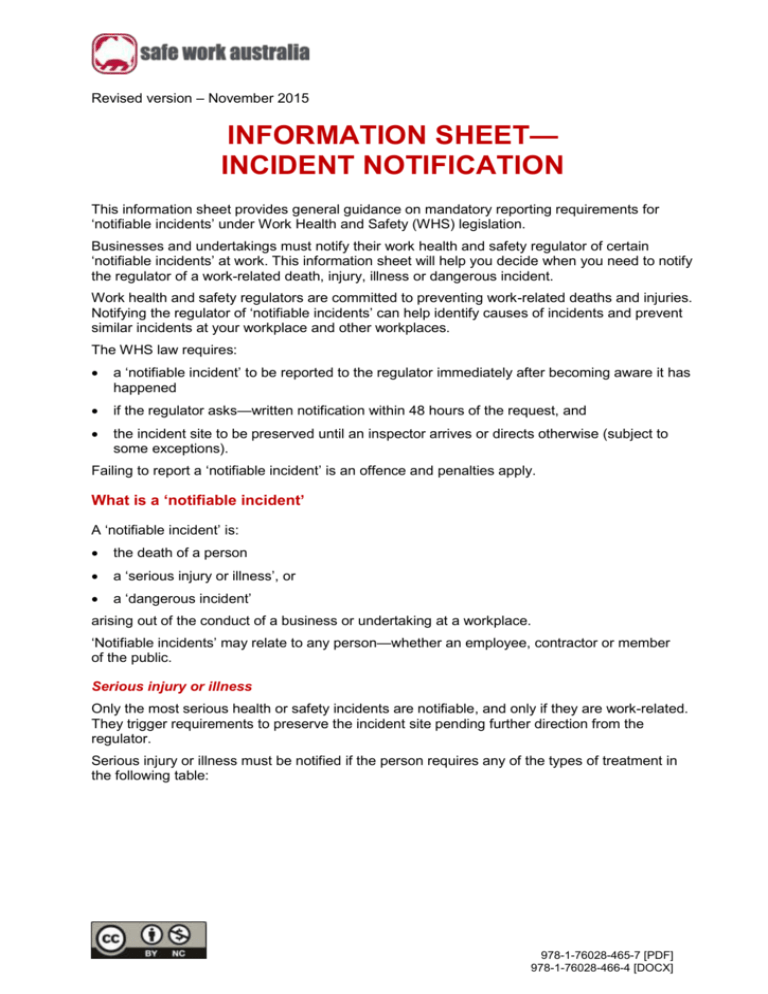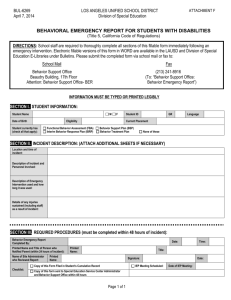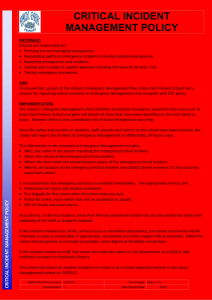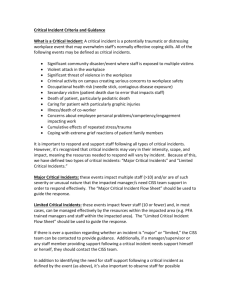Incident notification fact sheet
advertisement

Revised version – November 2015 INFORMATION SHEET— INCIDENT NOTIFICATION This information sheet provides general guidance on mandatory reporting requirements for ‘notifiable incidents’ under Work Health and Safety (WHS) legislation. Businesses and undertakings must notify their work health and safety regulator of certain ‘notifiable incidents’ at work. This information sheet will help you decide when you need to notify the regulator of a work-related death, injury, illness or dangerous incident. Work health and safety regulators are committed to preventing work-related deaths and injuries. Notifying the regulator of ‘notifiable incidents’ can help identify causes of incidents and prevent similar incidents at your workplace and other workplaces. The WHS law requires: a ‘notifiable incident’ to be reported to the regulator immediately after becoming aware it has happened if the regulator asks—written notification within 48 hours of the request, and the incident site to be preserved until an inspector arrives or directs otherwise (subject to some exceptions). Failing to report a ‘notifiable incident’ is an offence and penalties apply. What is a ‘notifiable incident’ A ‘notifiable incident’ is: the death of a person a ‘serious injury or illness’, or a ‘dangerous incident’ arising out of the conduct of a business or undertaking at a workplace. ‘Notifiable incidents’ may relate to any person—whether an employee, contractor or member of the public. Serious injury or illness Only the most serious health or safety incidents are notifiable, and only if they are work-related. They trigger requirements to preserve the incident site pending further direction from the regulator. Serious injury or illness must be notified if the person requires any of the types of treatment in the following table: 978-1-76028-465-7 [PDF] 978-1-76028-466-4 [DOCX] Types of treatment Example Immediate treatment as an in-patient in a hospital Admission into a hospital as an in-patient for any duration, even if the stay is not overnight or longer. It does not include: Out-patient treatment provided by the emergency section of a hospital (i.e. not requiring admission as an in-patient) Admission for corrective surgery which does not immediately follow the injury (e.g. to fix a fractured nose). Immediate treatment for the amputation of any part of the body Amputation of a limb such as arm or leg, body part such as hand, foot or the tip of a finger, toe, nose or ear. Immediate treatment for a serious head injury Fractured skull, loss of consciousness, blood clot or bleeding in the brain, damage to the skull to the extent that it is likely to affect organ/face function. Head injuries resulting in temporary or permanent amnesia. It does not include: A bump to the head resulting in a minor contusion or headache. Immediate treatment for a serious eye injury Injury that results in or is likely to result in the loss of the eye or total or partial loss of vision. Injury that involves an object penetrating the eye (for example metal fragment, wood chip). Exposure of the eye to a substance which poses a risk of serious eye damage. It does not include: Eye exposure to a substance that merely causes irritation. Immediate treatment for a serious burn A burn requiring intensive care or critical care which could require compression garment or a skin graft. It does not include: A burn that merely requires washing the wound and applying a dressing. Immediate treatment for the separation of skin from an underlying tissue (such as degloving or scalping) Separation of skin from an underlying tissue such that tendon, bone or muscles are exposed (de-gloving or scalping). Immediate treatment for a spinal injury Injury to the cervical, thoracic, lumbar or sacral vertebrae including the discs and spinal cord. It does not include: Minor lacerations. It does not include: Acute back strain. Information Sheet: Incident Notification November 2015 Page 2 of 10 Types of treatment Example Immediate treatment for the loss of a bodily function Loss of consciousness, loss of movement of a limb or loss of the sense of smell, taste, sight or hearing, or loss of function of an internal organ. It does not include: Immediate treatment for serious lacerations Mere fainting A sprain or strain. Deep or extensive cuts that cause muscle, tendon, nerve or blood vessel damage or permanent impairment. Deep puncture wounds. Tears of wounds to the flesh or tissues—this may include stitching to prevent loss of blood and/or other treatment to prevent loss of bodily function and/or infection. Medical treatment within 48 hours of exposure to a substance ‘Medical treatment’ is treatment provided by a doctor. Exposure to a substance includes exposure to chemicals, airborne contaminants and exposure to human and/or animal blood and body substances. Notification is also required for the following serious illnesses: Any infection where the work is a significant contributing factor. This includes any infection related to carrying out work: (i) with micro-organisms (ii) that involves providing treatment or care to a person (iii) that involves contact with human blood or body substances (iv) that involves handling or contact with animals, animal hides, skins, wool or hair, animal carcasses or animal waste products. The following occupational zoonoses contracted in the course of work involving handling or contact with animals, animal hides, skins, wool or hair, animal carcasses or animal waste products: (i) Q fever (ii) Anthrax (iii) Leptospirosis (iv) Brucellosis (v) Hendra Virus (vi) Avian Influenza (vii) Psittacosis. Treatment ‘Immediate treatment’ means the kind of urgent treatment that would be required for a serious injury or illness. It includes treatment by a registered medical practitioner, a paramedic or registered nurse. ‘Medical treatment’ refers to treatment by a registered medical practitioner (a doctor). Information Sheet: Incident Notification November 2015 Page 3 of 10 Even if immediate treatment is not readily available, for example because the incident site is rural or remote or because the relevant specialist treatment is not available, the notification must still be made. Still unsure? If you are still unsure about whether a particular incident should be notified then contact your regulator for advice or further guidance. Contact details are included below. Dangerous incidents including ‘near misses’ Some types of work-related dangerous incidents must be notified even if no-one is injured. The regulator must be notified of any incident in relation to a workplace that exposes any person to a serious risk resulting from an immediate or imminent exposure to: an uncontrolled escape, spillage or leakage of a substance an uncontrolled implosion, explosion or fire an uncontrolled escape of gas or steam an uncontrolled escape of a pressurised substance electric shock: o examples of electrical shock that are not notifiable shock due to static electricity ‘extra low voltage’ shock (i.e. arising from electrical equipment less than or equal to 50V AC and less than or equal to 120V DC) defibrillators are used deliberately to shock a person for first aid or medical reasons o examples of electrical shocks that are notifiable minor shock resulting from direct contact with exposed live electrical parts (other than ‘extra low voltage’) including shock from capacitive discharge the fall or release from a height of any plant, substance or thing the collapse, overturning, failure or malfunction of, or damage to, any plant that is required to be design or item registered under the Work Health and Safety Regulations, for example a collapsing crane the collapse or partial collapse of a structure the collapse or failure of an excavation or of any shoring supporting an excavation the inrush of water, mud or gas in workings, in an underground excavation or tunnel, or the interruption of the main system of ventilation in an underground excavation or tunnel. A dangerous incident includes both immediate serious risks to health or safety, and also a risk from an immediate exposure to a substance which is likely to create a serious risk to health or safety in the future, for example asbestos or hazardous chemicals. Only work-related incidents are notifiable To be notifiable, an incident must arise out of the conduct of the business or undertaking. An incident is not notifiable just because it happens at or near a workplace. Incidents may happen for reasons which do not have anything to do with work or the conduct of the business or undertaking, for example: a worker or another person suffers a heart attack while at work which is unrelated to work or the conduct of the business or undertaking Information Sheet: Incident Notification November 2015 Page 4 of 10 an amateur athlete is injured while playing for the local soccer team and requires immediate medical treatment (this is not work) a person driving to work is injured in a car accident (where driving is not part of their work) a person with epilepsy has a seizure at work. These kinds of incidents are not notifiable. Work-related incidents that occur outside a workplace may be notifiable Work-related incidents may affect people outside the workplace. These may still be notifiable if they involve a death, serious illness or injury or a dangerous incident. For example: an object like a hand tool falls off a multi-storey building under construction hitting a person below scaffold collapse that causes a risk of serious injury to persons adjacent to a construction site an awning over a shop-front collapses, hitting a person underneath it. Appendix A provides more information about incidents at public places or sporting events. Who is responsible for notifying? Any person conducting a business or undertaking (PCBU) from which the ‘notifiable incident’ arises must ensure the regulator is notified immediately after becoming aware it has happened. Procedures should be put into place to ensure work health and safety incidents are promptly notified to the people responsible for responding to them, for example a manager and then notified to the regulator, if required. Incidents involving multiple businesses or undertakings If a ‘notifiable incident’ arises out of more than one business or undertaking then each must ensure that the incident has been notified to the regulator. There is no need for all duty holders to notify—only one needs to. However, all duty holders retain their responsibility to notify, regardless of any agreement between them. In these circumstances the duty holders must, so far as is reasonably practicable, consult, cooperate and coordinate to put appropriate reporting and notification arrangements in place. For example contractors at a construction workplace may agree that the principal contractor for the workplace will notify all ‘notifiable incidents’ that occur at the workplace. Incidents involving a ‘State-based contractor working for a Commonwealth entity’ Workplaces shared by a Commonwealth entity and one or more state-based contractors may be covered by both Commonwealth and state or territory work health and safety (WHS) laws. For example an asbestos removal company is engaged by the Department of Defence (Defence) to carry out asbestos removal work at Randwick Army Barracks in Sydney and a dangerous incident occurs (as defined above). Because the incident has occurred at a place where work is carried out for Defence (on behalf of the Commonwealth) the company must ensure that both Comcare and WorkCover NSW are notified of the incident. Defence and the company may co-operate so that only one notification is made to Comcare on behalf of both. When and how to notify You must notify the regulator immediately after becoming aware of a ‘notifiable incident’. Information Sheet: Incident Notification November 2015 Page 5 of 10 The notice must be given by the fastest possible means—which could be by telephone or in writing, for example by email or online (if available). See page 8 for contact details. Regulators have adopted a common-sense approach to assessing whether an incident has been notified immediately. This means incidents must be notified as soon as the particular circumstances permit. In general a PCBU ‘becomes aware’ of a notifiable incident once any of their supervisors or managers becomes aware of the incident. For example when a worker suffers a serious injury and reports it to their immediate supervisor, it is at this point that the PCBU is considered to be aware of the incident. It is therefore essential to develop internal communication systems to ensure health or safety incidents are promptly brought to the relevant persons’ attention. What information will be requested? At first, the regulator will ask for a clear description of the incident with as much detail as possible. This will help the regulator assess whether or not the incident is notifiable and the need for a follow-up investigation. The following information is usually requested: What happened: an overview When did it happen Date and time. Where did it happen Incident address. Provide an overview of what happened. Nominate the type of notifiable incident—was it death, serious injury or illness, or ‘dangerous incident’ (as defined above)? Details that describe the specific location of the notifiable incident—for example section of the warehouse or the particular piece of equipment that the incident involved—to assist instructions about site disturbance. What happened Detailed description of the notifiable incident. Who did it happen to Injured person’s name, date of birth, address and contact number. Injured person’s occupation. Relationship of the injured person to the entity notifying. How and where are they being treated (if applicable) Description of serious injury or illness—i.e. nature of injury Initial treatment of serious injury or illness. Where the patient has been taken for treatment. Who is the person conducting the business or undertaking (there may be more than one) Legal and trading name. Business address (if different from incident address), ABN/ACN and contact details including phone number and email. What has/is being done Action taken or intended to be taken to prevent recurrence (if any). Who is notifying Notifier’s name, contact phone number and position at workplace. Name, phone number and position of person to contact for further information (if different from above). Notify immediately, and provide the information you can, even if you do not have all of the required information. Information Sheet: Incident Notification November 2015 Page 6 of 10 The regulator may follow-up with a request for more information later if necessary. You must provide the required information in writing within 48 hours of the request being made. Can work continue where the incident occurred? An incident site must not be disturbed until an inspector arrives at the site or directs otherwise (whichever is earlier). The person with management or control of the workplace is responsible for preserving the incident site, so far as is reasonably practicable. Any evidence that may assist an inspector to determine the cause of the incident must be preserved—including any plant, substance, structure or thing associated with the incident. However, preserving an incident site does not prevent any action needed: to assist an injured person to remove a deceased person to make the site safe or to minimise the risk of a further notifiable incident, or to facilitate a police investigation. The sooner the regulator is notified, the sooner the site can be released. An inspector may issue a non-disturbance notice, if they consider that the incident site should remain undisturbed in order to facilitate their investigation. This notice must specify the period for which the notice is to apply—no more than seven days. Penalties apply if an individual or body corporate fails to preserve a site. Site preservation requirements only apply to the incident site Requirements to preserve a site only apply to the area where the incident occurred—not the whole workplace. If you are unsure about what you need to do, you can ask the regulator for advice or to be excused from having to preserve the site. Amending notifications If you receive information that changes the incident type of a notified incident, you must notify the regulator of those changes. For example, if a notified serious injury or illness later results in the person’s death, the regulator must be advised immediately upon you learning that the person has died. Record keeping requirements Records of notifiable incidents must be kept for at least five years from the date of notification. Penalties apply for failing to do so. It is useful to keep a record of having made the notification (e.g. confirmation from the regulator), and also any directions or authorisations given by an inspector at the time of notification. Information Sheet: Incident Notification November 2015 Page 7 of 10 Contact details for regulators To notify a ‘notifiable incident’ contact your local regulator: Jurisdiction Regulator Telephone Website New South Wales SafeWork NSW 13 10 50 safework.nsw.gov.au Victoria WorkSafe Victoria 1800 136 089 worksafe.vic.gov.au Queensland WorkSafe Queensland 1300 369 915 worksafe.qld.gov.au South Australia SafeWork SA 1800 777 209 safework.sa.gov.au Western Australia WorkSafe WA 1300 307 877 commerce.wa.gov.au/Work Safe/ Australian Capital Territory WorkSafe ACT 02 6207 3000 worksafe.act.gov.au/health safety Tasmania WorkSafe Tasmania 1300 366 322 (Tas) worksafe.tas.gov.au 03 6233 7657 (External) Northern Territory NT WorkSafe 1800 019 115 worksafe.nt.gov.au Commonwealth Comcare 1300 366 979 comcare.gov.au Information Sheet: Incident Notification November 2015 Page 8 of 10 Appendix A Public places and sporting events Workplaces may also be public or partly public places, for example: public parks, streets public transport shopping centres sports facilities schools and colleges aged care facilities, hospitals and medical centres cafes, restaurants, hotels and other kinds of public accommodation. Incidents involving bystanders, visitors, students, patrons or other members of the public are only notifiable if: there is a death a ‘serious injury or illness’ is suffered or there is a dangerous incident (‘near miss’ as described above), and the incident arises out of the conduct of a business or undertaking. An incident may arise out of the conduct of a business or undertaking for example because of: the way a work activity is organised (for example inadequate safety precautions) the way equipment or substances are used (for example lifts, machinery) the condition of a workplace (for example poorly maintained or slippery floors) actions of someone who is not a worker at the workplace. If a visitor at a shopping centre is taken to hospital after sustaining a serious fracture then the incident would be notifiable. If a visitor is taken to hospital because of their pre-existing medical condition (for example heart attack, epileptic seizure at a shop) this would not be notifiable as it did not result from the conduct of the business or undertaking. Incidents during sports activities Work health and safety duties apply in relation to professional sports people for whom sport is work and sport organised by businesses or undertakings. They do not apply to purely social or recreational activities or activities organised by wholly volunteer associations that do not employ anyone. For more information about the way the work health and safety laws affect volunteers and organisations with volunteers refer to the online resource kit published by Safe Work Australia. Some sports injuries may arise from ‘work’ (for example a professional AFL footballer) while others may not (a local amateur club footballer). Sports injuries are not notifiable if arising out of the normal conduct of a sports activity for example rough and tumble of a game. Sports injuries are notifiable only if arising out of the conduct of a business or undertaking for example: the way a work activity involving sport is arranged Information Sheet: Incident Notification November 2015 Page 9 of 10 the way the sporting activity is managed or controlled the condition, design or maintenance of premises or equipment, or the way work is carried out, for example inadequate supervision. Examples of notifiable incidents include: the condition of the premises or sports equipment was a factor in the incident—for example where a participant suffers an injury requiring admission as an inpatient at a hospital due to tripping over on a potholed tarmac surface, or there was inadequate supervision to prevent an incident—like ensuring the safe use of equipment used by students on a school excursion or failings in the organisation and management of an event. Information Sheet: Incident Notification November 2015 Page 10 of 10









